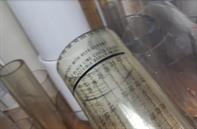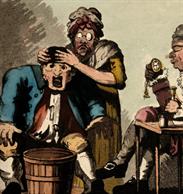Does butyrate stink?
It’s a misguided question and we get it all of the time. Our basic answer is “No, butyrate does not stink; butyric acid stinks.” We extrude CAB tubing: Cellulose Acetate Butyrate formula 576E (with odor mask). Frankly, next to common acrylic it smells pretty good (in production).
The problem is that CAB, after its time can stink (badly) when it decomposes. In certain conditions of use or storage, it can slowly release butyric acid. Butyric acid stinks.
Butyric acid, a small carboxylic is pungent!
It has a reek of sour milk, or spoiled butter (its etymology is from the Latin butyrum meaning butter). Other comparisons are parmesan cheese, body odor, or put it in King James or Shakespearean English, “puke.” This is not surprising, for butyric acid serves a purpose in our digestive tracts, it is found in the brain and can be purchased online as a supplement. In high concentrations, it has been outlawed as (Gamma hydroxybutyric acid) is often the primary ingredient in “date rape” drugs.
Generally, CAB tubing, properly extruded and under normal conditions, will not smell for over a decade, or even two. In our sample room, we have several tubes that go back 3 decades. Pictured to the right we have an old “Dial a Charge” from Robinair Mfg. Corp (right). The yellow color of the tube shows that time, light, and oxygen have taken their toll. The tube is yellow, and butyric acid is slowly being released. It’s not mindblowing, but it’s not pleasant either.

In its younger days, the printed tube was clear with only a moderate to undetectable odor (left).

What happened?
Cellulose acetate butyrate (CAB) is a common thermoplastic and due to its warm feel, tool handles are often composed of this resin. It can be thermoformed over and over, and due to its cellulosic characteristics, it can be easily sawed, drilled, and punched. It is a relatively tough plastic (stretchy before breaking) that can be transparent, translucent, opaque, and colored.
CAB is more expensive than its precursor; cellulose acetate and CAB with a UV stabilizer last many years.
Producers make it by reacting esters of cellulose with acetic acid and butyric acid; this also gives it low moisture absorption and an extremely high level of impact strength. CAB has been around for the past 150 years. But, upon breakdown, CAB will release its esters as acetic acid, and butyric acid. And yes, this smells bad and the smell migrates.
Can we fix the stink? It’s not worth it. A caustic wash will saponify the surface of the tube which essentially turns the outer surface of the material back into cellulose. A 10% bleaching in warm Drano (Na2OH) followed by drying and an application of CAB dissolved in acetone will work somewhat. The Drano strips off surface acetyls and butyrls leaving a much more water adsorbing surface on the CAB. The application of dissolved CAB forms a newer skin. But, the inside of the wall will continue to break down.

